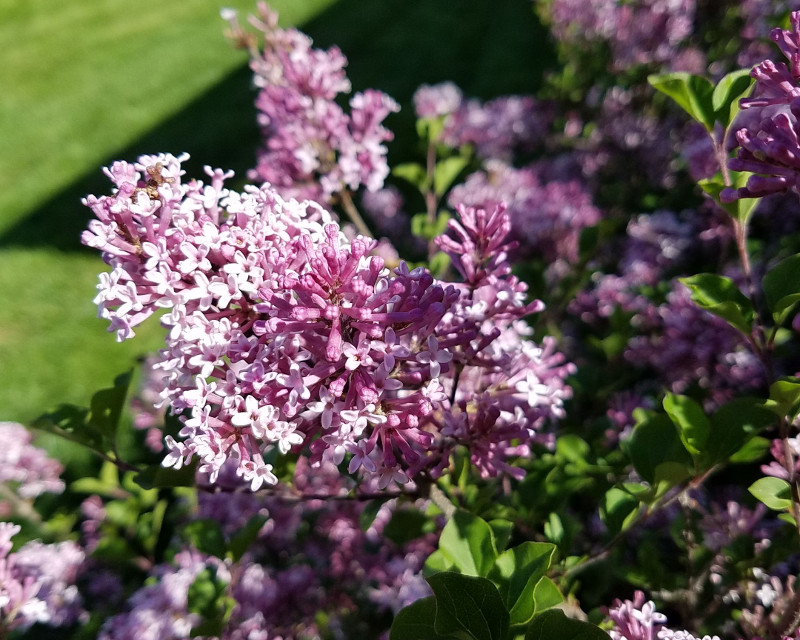Many flowering shrubs, such as the common lilac (Syringa vulgaris), need regular pruning to promote blooming the following year. Your lilac plant will continue to bloom with little effort from you; however, if left to grow wild, your lilac will only flower on the uppermost branches. Annual pruning will result in the lovely round shape that gardeners desire. Annual pruning creates a balance between older stems and newer, flowering shoots. This is referred to as “deadheading.”

In addition to deadheading your plant, you will want to remove any shoots (growth on the base of the shrub). This will thin out the shrub and enhance the shape of your beautiful plant. Dwarf lilacs, such as our Bloomerang® Dwarf Pink Lilac, require very little pruning. Annual deadheading just after the flowers have faded in the spring is important for bountiful flower production the following year.
When to Prune Lilac
Knowing when to prune a lilac plant is important for next year’s flowering production. Lilacs set next season’s blooms on this year’s wood. So you need to prune right after the flowers have died.
The best time to prune your lilac bush is just after the flowers have faded in the spring. This allows the shoots time over the summer to prepare for the next season of blooms. Pruning lilacs too late can kill young, developing buds. Some summer pruning can be done on particularly vigorous plants, but not after mid-July.

How to Prune Lilacs
Pruning your lilac plant helps to promote growth of the flowering blooms for the next season. Annual pruning creates a balance between older stems and newer, flowering shoots. This is referred to as deadheading- removing dead blooms from the plant by hand. Common garden clippers will work for this task. The following are three areas to focus on when pruning your lilac bush.
Step 1 - Trimming off flowers
Simply snip off the dead flowers from your plant. If you can see next year’s blooms forming (two new shoots coming from the stem), snip just the spent bloom’s stem to prevent cutting off next season’s flowers.
Step 2 - Pruning the shrub
Trim long stems to maintain the shape of the shrub. A general rule is not to prune more than one third of the shrub’s stems per year. Thinning of the shrub encourages new growth. An older shrub that has not been well maintained, may need a more aggressive pruning. Cut older, malformed stems down to the ground.
Step 3 - Removing lilac suckers
Suckers are new lilac plants that shoot up from the soil. Cut them off at the soil line. You will want to leave stems growing close to the trunk of the shrub intact , as a healthy lilac has a mix of old and new growth.

Why Do You Prune Lilacs
Lilacs are hardy plants that produce colorful, fragrant, flowering blooms every spring. Annual pruning of your shrub is important for their health and flower production. If properly pruned each year, lilac shrubs will come back stronger each year. As a lilac stem gets older, the flowers become smaller and fewer. Annual pruning creates a balance between older stems and newer, flowering shoots. This is referred to as deadheading.
Deadheading directs the plant’s energy into new growth. Removing unproductive, dead, or diseased stems from your plant makes room for healthy stems. You may have a healthy productive stem that just grows too tall. It is fine to cut it back to a desired height.
On the other hand, old less productive stems should be cut back to the ground. New shoots and suckers growing around the base of the plant should be cut back to promote spacing between plants.
With dwarf lilacs, such as our Bloomerang® Dwarf Pink Lilac, you may want to encourage a second blooming towards the end of summer or early fall. Pruning off the spent blooms will encourage a productive second bloom time. Blooms are very dependent on weather. A summer with extreme heat will yield fewer flowers. As long as your plant is well maintained with pruning, the flowers will follow the next season.
Lilac Pruning Tips
- Yearly pruning keeps lilacs under control
- Pruning promotes flowering growth
- Prune after the spring blooms have died
- Deadhead as soon as the flowers fade
- Remove lilac suckers
 |
Author Chris Link - Published 12-11-2020 |
